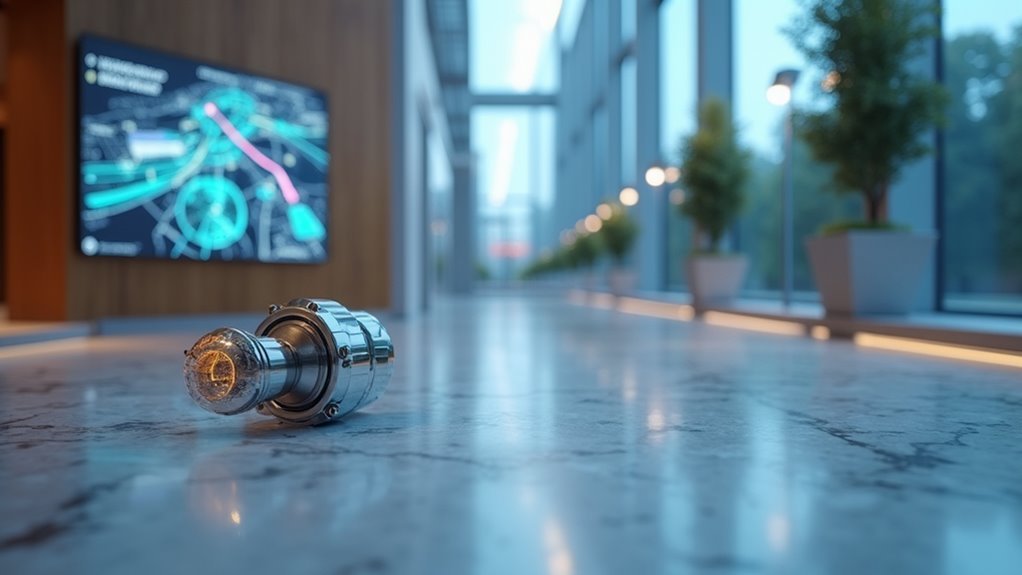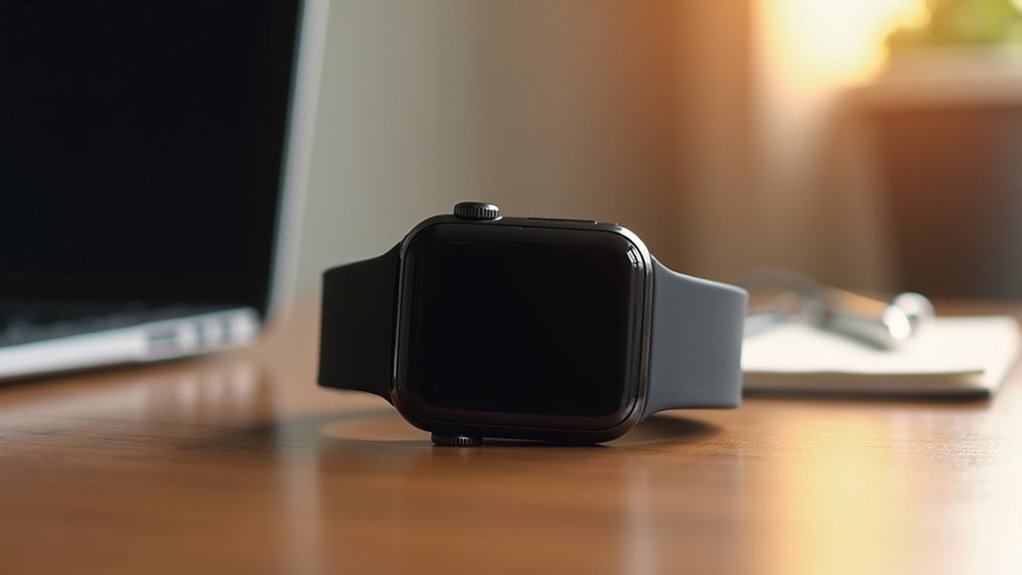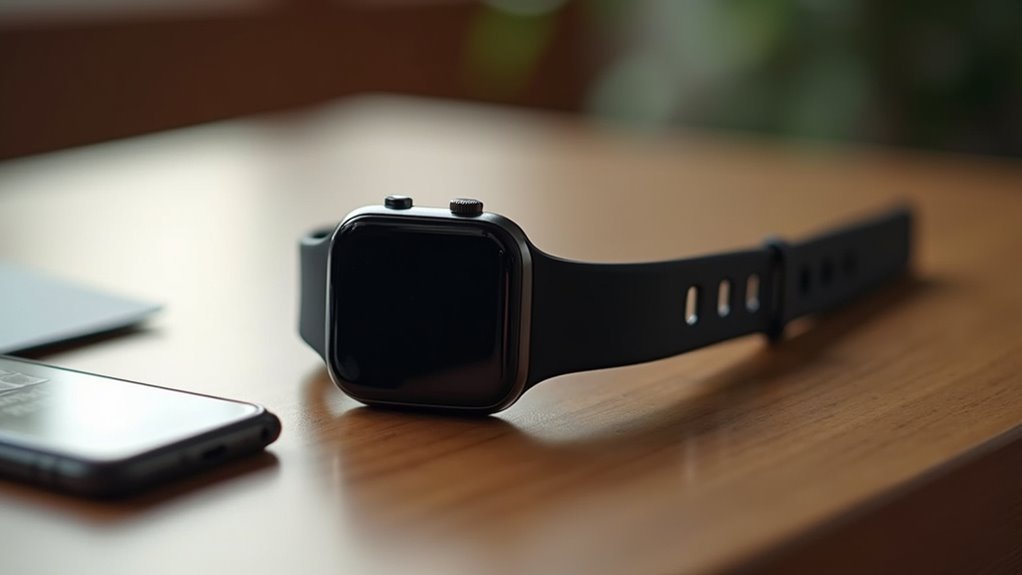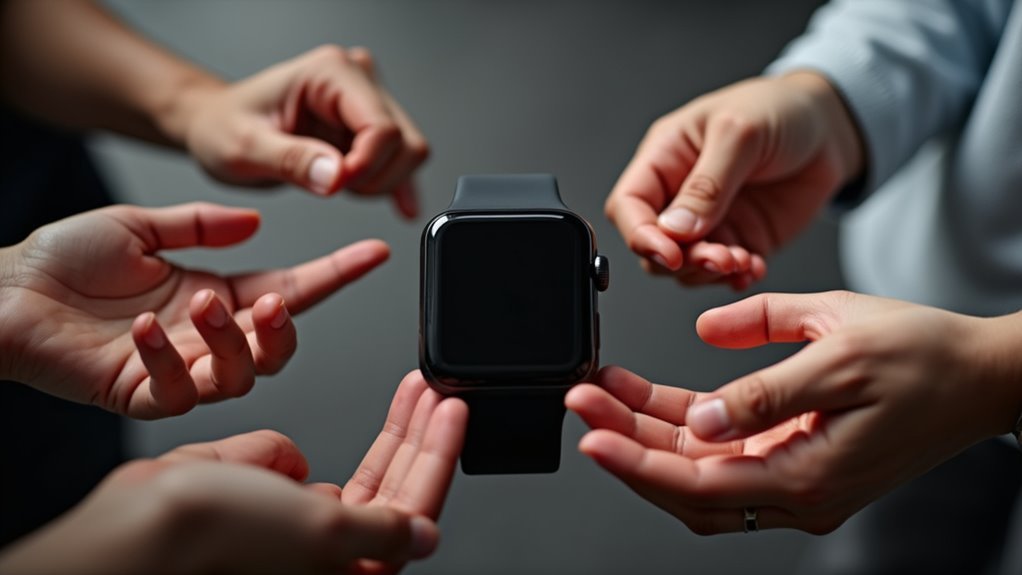You’ll discover that barometric pressure sensors revolutionize your daily tech experience through enhanced GPS altitude accuracy in challenging environments, real-time weather pattern detection that predicts storms before they’re visible, precise indoor floor-level navigation capabilities, seamless health monitoring for conditions like migraines and arthritis, improved fitness tracking through better activity recognition, extended battery life via smart sensor management, and reliable backup navigation when GPS signals fail. These hidden capabilities transform ordinary devices into sophisticated atmospheric monitoring systems that’ll open entirely new possibilities for your adventures.
Enhanced Altitude Accuracy for Outdoor Adventures

When you’re traversing rugged terrain or scaling mountain peaks, barometric pressure sensors deliver the precise altitude measurements you need for safe and successful outdoor adventures.
These sensors offer remarkable accuracy, providing readings within ±0.5 meters for relative measurements, making them invaluable for climbers and hikers planning routes and ensuring safety.
With sub-meter precision, barometric pressure sensors provide the critical accuracy outdoor enthusiasts need for reliable route planning and essential safety navigation.
Whether you’re paragliding, cycling, or running, real-time altitude data enhances your performance tracking and training strategies.
The sensors excel in geocaching and orienteering activities, delivering precise location detection that makes navigation more efficient.
When integrated with GPS systems, they greatly improve absolute altitude accuracy, giving you reliable measurements even in challenging environments.
You’ll also benefit from their compact, energy-efficient design that seamlessly integrates into wearable devices and portable gadgets.
These sensors maintain reliable performance across extreme temperature ranges from -40 to 85°C, ensuring consistent operation in the harshest outdoor conditions.
Real-Time Weather Pattern Detection on Your Wrist
As you navigate through your day, barometric pressure sensors on your wrist continuously monitor atmospheric conditions, delivering real-time weather data that keeps you informed about environmental changes.
These sensors measure ambient air pressure several times per second, reporting sea level readings for accurate weather tracking regardless of your location.
When sudden pressure drops occur, your smartwatch triggers storm alerts directly on your wrist—often before you notice visible weather signs. This precision detection, accurate to ±0.002 hPa, helps you make informed safety decisions in real-time.
The sensors also record historical pressure trends, enabling your device to identify recurring weather patterns and anomalies. This data seamlessly integrates with weather widgets and watch faces, providing extensive forecasting that informs your daily activity planning. Many devices feature auto mode functionality that intelligently switches between altimeter and barometer modes based on detected changes.
Precise Indoor Floor-Level Navigation Capabilities

Beyond outdoor weather tracking, barometric pressure sensors in your devices reveal precise indoor navigation capabilities that transform how you navigate complex multi-story environments.
These sensors detect elevation changes as small as a few centimeters, enabling accurate floor identification where GPS signals fail. Your smartphone automatically tracks which floor you’re on in shopping malls, hospitals, or parking garages, while wearables leverage this technology for seamless indoor-outdoor navigation shifts.
The sensors support critical applications like emergency response systems that pinpoint your exact location, asset tracking in commercial buildings, and navigation assistance for visually impaired individuals. Modern barometric sensors deliver exceptional long-term stability with drift of only ±0.16 hPa over 12 months, ensuring reliable performance for continuous indoor positioning applications.
Barometric sensors enable life-saving emergency location services, commercial asset tracking, and accessibility navigation tools for visually impaired users.
With low power consumption and robust performance across varying conditions, they’re opening new possibilities for smart building automation, augmented reality navigation, and advanced health tracking features that monitor precise vertical movements.
Improved GPS Performance in Challenging Environments
When you’re maneuvering through urban canyons or dense forests, your GPS device struggles with weak satellite signals that compromise location accuracy.
You’ll find that barometric pressure sensors greatly enhance altitude measurements in these challenging environments, providing reliable vertical positioning data even when GPS signals fade.
These sensors compensate for signal loss by maintaining continuous altitude tracking, ensuring you won’t lose critical navigation information in areas where traditional GPS performance deteriorates. The three-dimensional coordinates are updated regularly to maintain accurate positioning even when satellite communication becomes intermittent.
Enhanced Altitude Accuracy
While GPS technology has revolutionized location tracking, it often struggles with altitude precision, particularly in challenging environments where satellite signals weaken or become unreliable.
Barometric pressure sensors solve this critical limitation by delivering superior altitude accuracy that you can depend on.
These sensors excel at measuring relative altitude changes with remarkable precision, making them perfect for tracking vertical movement in multi-story buildings or complex terrain.
Here’s what makes barometric altitude measurement superior:
- Exceptional Accuracy: Delivers precision within 0.17 to 0.5 meters, often surpassing GPS performance
- Dynamic Calibration: Fuses with GPS data to continuously improve absolute altitude readings
- High-Resolution Tracking: Provides detailed spatial data for maneuvering complex indoor spaces
The BMP388’s incredibly low noise of just 0.03 Pa ensures stable, precise measurements even in demanding conditions.
You’ll experience consistent, reliable altitude data that GPS alone simply can’t match.
Urban Canyon Navigation
As cities continue their vertical expansion with a 650% increase in tall buildings over just five years, GPS systems face mounting challenges in dense urban environments where high-rise structures create “urban canyons” that block and reflect satellite signals.
You’ll find that even three-story buildings can disrupt GPS accuracy, reducing positioning precision to around 5 meters – enough to cause wrong turns and misdirections.
When GPS signals can’t reach satellites effectively, barometric pressure sensors become vital backup tools. They provide essential altitude data that helps triangulate your location when satellite visibility is compromised. Advanced systems now incorporate 3D building models to predict satellite visibility and measurement errors, significantly improving positioning accuracy in challenging urban environments.
Signal Loss Compensation
Beyond the challenges of urban canyons, you’ll encounter even more severe GPS disruptions when signals weaken or disappear entirely due to atmospheric interference, tunnel passages, or dense foliage cover.
That’s where barometric pressure sensors become your navigation lifeline, compensating for signal loss through intelligent sensor fusion.
Your system can now operate with remarkable flexibility:
- Reduced satellite dependency – You’ll need fewer GPS satellites for accurate positioning when barometric height data constrains your position estimates.
- Multi-sensor redundancy – Your navigation continues seamlessly by combining GPS, barometer, and gyroscope data through decentralized filtering algorithms.
- Adaptive operation modes – You can switch between GPS-only, GPS-barometer, or full multi-sensor configurations based on signal availability.
These sensors maintain their effectiveness across various conditions since they’re durable and suitable for use in diverse environments, including high humidity areas. This enhanced robustness guarantees you maintain accurate navigation even when GPS signals become unreliable or completely unavailable.
Advanced Health Monitoring Through Atmospheric Awareness
You can revolutionize health monitoring by leveraging barometric pressure sensors that detect atmospheric changes affecting conditions like arthritis, migraines, and altitude sickness.
These sensors enable precise medical device calibration while establishing clear correlations between weather patterns and your health symptoms.
With portable monitoring solutions integrated into wearables, you’ll gain continuous insights into how atmospheric pressure variations impact your well-being. The temperature compensation circuits ensure reliable readings across varying environmental conditions for consistent health tracking accuracy.
Medical Device Calibration
When medical devices require precise calibration to deliver accurate health monitoring, barometric pressure sensors provide the atmospheric awareness necessary to maintain ideal performance.
You’ll find these sensors automatically compensate for atmospheric pressure fluctuations that could skew device output, ensuring your ventilators and oxygen monitors maintain measurement reliability.
Your calibration processes benefit from three key improvements:
- Automated compensation protocols that prevent drift and maintain device stability across varying environmental conditions
- Real-time calibration verification through continuous atmospheric data inputs and multi-point communication interfaces
- Reduced manual recalibration frequency with recommended 180-day intervals, freeing healthcare resources and minimizing downtime
You’ll achieve metrology-grade calibration standards while supporting compliance with stringent health industry requirements through standardized device baselines. These transducers operate reliably within remote distances up to 4000 feet, enabling flexible installation configurations in large medical facilities.
Weather Health Correlations
While atmospheric pressure fluctuations might seem insignificant to daily health, barometric pressure sensors enable healthcare providers to predict and manage weather-related symptom flare-ups with unprecedented precision.
You’ll benefit from early warnings when atmospheric changes threaten to trigger migraines, worsen arthritis pain, or affect your blood pressure readings. These sensors detect pressure drops that typically increase inflammation and pain sensitivity, allowing proactive medication timing and lifestyle adjustments.
Your chronic condition management becomes more effective when integrated with real-time barometric data. Healthcare providers can correlate your symptom patterns with atmospheric conditions, creating personalized treatment protocols. Research indicates that blood glucose levels vary with atmospheric pressure, making these sensors particularly valuable for diabetic patients monitoring their condition.
This weather-health awareness proves especially valuable for patients with rheumatoid arthritis, hypertension, and chronic back pain, transforming reactive symptom management into predictive healthcare strategies.
Portable Monitoring Solutions
Advanced portable barometric pressure sensors transform health monitoring by delivering laboratory-grade atmospheric data directly to your smartphone or handheld device.
You’ll access precision readings with 0.03% accuracy while maintaining complete mobility throughout your daily routine. These compact devices enable continuous tracking of atmospheric changes that influence respiratory and cardiovascular conditions outside clinical settings.
Key advantages of portable barometric monitoring include:
- Real-time alerts – Smart alarm features notify you when pressure deviates beyond health-related thresholds
- Seamless integration – RS-232/RS-485 ports connect with broader health monitoring networks and mobile apps
- Extended analysis – Data logging capabilities support historical trend identification for predicting health event triggers
You’ll gain personalized insights by correlating barometric pressure trends with your symptoms, enabling proactive management of pressure-sensitive conditions like migraines and arthritis. Modern sensors compensate for temperature variations from 0 to 50°C, ensuring reliable measurements across different environmental conditions.
Seamless Integration With Fitness and Activity Tracking
As fitness enthusiasts demand more sophisticated tracking capabilities, barometric pressure sensors have emerged as vital components that seamlessly integrate with existing activity monitoring systems.
You’ll experience enhanced activity recognition as these sensors work alongside accelerometers and gyroscopes, dramatically improving accuracy when classifying activities like sitting, standing, walking, or lying down.
These compact, low-power sensors won’t drain your device’s battery while providing precise altitude detection essential for hiking and running activities.
Efficient barometric sensors deliver essential altitude tracking for outdoor activities without compromising your device’s battery life or performance.
You’ll get more accurate step counting through elevation context, plus enhanced fall detection that monitors sudden pressure changes for safety features.
The innovative gel package design provides exceptional protection against sweat, rain, and other contaminants encountered during intense workouts and outdoor activities.
The data fusion capability combines barometric readings with other sensor inputs, delivering detailed movement analysis and extensive workout insights that transform your fitness tracking experience into a precision monitoring system.
Extended Battery Life Through Smart Sensor Management

When you’re relying on barometric pressure sensors for extended monitoring periods, smart power management becomes the difference between months and years of continuous operation.
Modern sensors achieve remarkable battery life through intelligent design and optimization strategies that minimize energy consumption without sacrificing accuracy.
Advanced sensors implement three key power-saving approaches:
- Intermittent sampling schedules that limit sensor uptime and reduce active power draw
- Local data storage with aggregated transmission to minimize wireless activity and processor usage
- Configurable wake-up/sleep cycles embedded in firmware that automatically manage energy consumption
You’ll find leading sensors delivering 4-8+ years of battery life using 3.6V batteries with smart management systems. These sophisticated devices utilize absolute pressure sensors that eliminate the need for additional components like desiccant tubes or bellows, further reducing maintenance requirements and power consumption.
These devices maintain exceptional accuracy while operating in sleep states, and firmware updates can further enhance power efficiency throughout the sensor’s deployment lifecycle.
Frequently Asked Questions
How Much Do Barometric Pressure Sensors Cost for Consumer Devices?
You’ll find barometric pressure sensors for consumer devices priced between $20-$80 each. You’re paying more for higher precision, weatherproofing, and specialized features like analog outputs or IoT integration capabilities.
Can Barometric Sensors Work Accurately in Extreme Weather Conditions?
You’ll find barometric sensors can work accurately in extreme weather when they’re built with quality materials like stainless steel and properly calibrated, though they’ll need regular maintenance for peak performance.
What Is the Typical Lifespan of MEMS Barometric Pressure Sensors?
You’ll find MEMS barometric pressure sensors typically last 10+ years with proper care. Environmental factors like temperature fluctuations and moisture exposure can reduce their lifespan, but quality manufacturing guarantees long-term reliability.
Do Barometric Sensors Require Regular Calibration or Maintenance?
You’ll need regular calibration for high-precision applications like aviation or laboratory work. Sensor drift occurs gradually, typically less than 1% annually. For basic weather monitoring, you can perform occasional accuracy checks instead.
Are There Privacy Concerns With Barometric Sensor Data Collection?
You should know that barometric sensors can collect sensitive data without explicit permission, potentially tracking your location and activities. Apps often access this information undetected, creating privacy risks you’re likely unaware of.
In Summary
You’ll discover that barometric pressure sensors transform your wearable device into a powerful tool that goes far beyond basic timekeeping. They’re revolutionizing how you navigate, monitor your health, and track activities while extending your device’s battery life. Whether you’re hiking mountains, climbing stairs, or simply wanting more accurate weather predictions, you can’t overlook the impact these sensors have on your daily adventures and overall user experience.





Leave a Reply